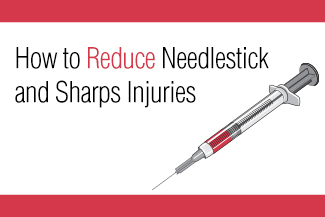Needlestick and sharps injuries are a major concern at hospitals, healthcare facilities, and laboratories. An estimated 800,000 injuries occur annually in the United States. A CDC study estimated that in the average hospital, workers incur approximately 30 reported needlestick injuries per 100 beds each year.
While the majority of these injuries don’t result in the transmission of infections, it’s important to take into account direct and indirect facility costs, and, more importantly, the emotional impact needlestick and sharps injuries can have on healthcare workers.
From the beginning of the blood draw to cleanup and disposal, there are a number of cross-contamination and bloodborne pathogens exposure risks. On top of step-by-step safety measures, the importance of well-designed and organized phlebotomy stations, carts, and trays can’t be stressed enough. Easy access to supplies and waste containers not only reduces accidents and injuries, but also expedites the blood-draw process.
Below are a few more easy-to-implement solutions that can reduce occurrences of needlestick and sharps injuries:
- PPE Apparel: It’s important to have well-fitting PPE apparel that won’t get in the way of your work – glove dispensers that can hold multiple sizes help ensure the gloves you need are always on hand, while lab coats with fitted cuffs and facemasks keep exposed skin covered and protected.

- Sharps Containers: 22% of injuries involving hollow-bore needles happen during or after disposal. Help reduce this number with puncture- and leak-resistant sharps containers that are always within easy reach of wherever sharps are being used. Look for containers that hook on carts and phlebotomy stations or hang easily on walls.
- Recapping Devices: OSHA prohibits recapping needles by hand unless no other alternative exists, but this practice still makes up 6% of needlestick injuries. Remain OSHA compliant and protect workers with needle protection and recapping devices.
- Transfer and IV Systems: Needle-free transfer devices, protected-needle IV systems, and IV catheters that encase needles after use are designed to prevent injuries while transferring blood and fluids from a syringe to a specimen container.
- Safety Needles and Shields: Studies have shown that phlebotomy injuries were reduced by up to 82% with the use of needle shields and safety needles including self-blunting or butterfly type.

